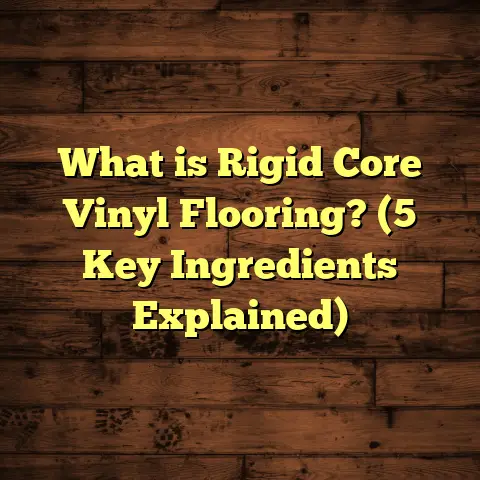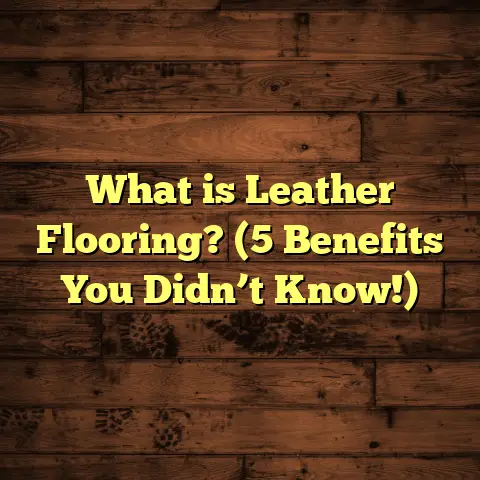What is Water-Resistant Flooring? (5 Key Benefits Revealed!)
I still remember the first time I had to deal with water damage on my floors. It was a weekend, and a pipe under the kitchen sink decided to spring a leak—right when I had guests coming over. The hardwood floor started swelling and warping before my eyes. That experience stuck with me and pushed me to learn everything I could about water-resistant flooring. Over the years, I’ve installed and worked with countless flooring options, and I want to share what I’ve learned about water-resistant flooring—the benefits, the technical details, and how it can really make a difference in your home.
What Is Water-Resistant Flooring?
So, what exactly is water-resistant flooring? Simply put, it’s any type of floor covering designed to resist water penetration better than traditional materials. Unlike waterproof flooring—which prevents water from passing through completely—water-resistant flooring can handle small amounts of moisture without damage. This makes it ideal for areas prone to spills, humidity, or occasional dampness.
Water-resistant flooring materials include vinyl, certain laminates, engineered hardwood with treated surfaces, and some types of tile. They have special coatings or construction that slows down or stops water from seeping in and causing problems like swelling, warping, or mold growth.
From a technical standpoint, water resistance usually comes from:
- Surface treatments: protective coatings applied to the top layer.
- Core materials: using synthetic or treated wood fibers that don’t absorb moisture easily.
- Installation methods: tight locking systems or adhesives that prevent water seepage between planks or tiles.
Understanding these basics helps you pick the right flooring for your space without worrying about water damage ruining your investment.
A Closer Look at Water Resistance vs. Waterproofing
It might sound like a small difference, but it’s important to know the distinction between water-resistant and waterproof flooring. Water-resistant floors can resist moisture but aren’t meant to be submerged in water or exposed to standing water for long periods. Waterproof floors are built to withstand standing water without damage.
For example, vinyl plank flooring often comes in waterproof varieties that can handle flooding or pet accidents without warping. Some laminates are only water-resistant—meaning that if water sits on them too long or seeps into the seams, damage can occur.
Knowing this difference helps you choose the right product for your specific needs.
Why Does Water Resistance Matter?
You might wonder, “Isn’t all flooring built to last?” The truth is, many popular flooring types—like traditional hardwood or carpet—are not suited for moisture-prone areas. Water can cause hardwood to swell and warp, laminate to peel and bubble, and carpets to develop mold and odors.
Remember that kitchen leak I mentioned? After the incident, I switched my kitchen floor to a water-resistant vinyl plank. Not only did it save me from future headaches, but it also gave the room a fresh look with zero worries about spills. I’ve seen this same relief reflected in many of my clients’ homes over the years.
Here are some real numbers: According to industry data, water damage accounts for nearly 40% of all flooring repairs in residential homes. That’s a huge chunk that could be avoided with the right choices.
The Science Behind Moisture Damage
Moisture causes damage by penetrating porous materials like wood or carpet fibers. When wood absorbs water, it swells and changes shape—a process called hydro-expansion. This leads to warping, cupping, or cracking.
Carpet fibers hold moisture too, creating a breeding ground for mold and mildew that not only damages the floor but can also affect indoor air quality.
Water-resistant floors use non-porous materials or treated surfaces that block moisture from entering below. This barrier is key to preventing costly repairs later on.
5 Key Benefits of Water-Resistant Flooring
1. Durability Against Moisture
One of the biggest advantages is straightforward: water-resistant floors handle moisture better. This means fewer worries about spills in kitchens, bathrooms, laundry rooms, or basements.
For example, vinyl flooring can withstand standing water for hours without damage. I once installed luxury vinyl planks (LVP) in a family’s basement that frequently experienced minor flooding during heavy rains. Months later, the floor looked as good as new.
This durability extends the lifespan of your floors and reduces costly repairs.
Data Point: According to a survey from the National Wood Flooring Association (NWFA), homes with water-resistant floors had 30% fewer moisture-related claims than those with traditional hardwood.
2. Easy Maintenance
I’ve found that water-resistant floors require less upkeep compared to traditional hardwood or carpet. They don’t soak up stains or odors as easily because liquids stay on the surface.
A quick mop or wipe is usually enough to keep them clean. This makes them perfect for busy homes with kids or pets.
In one case study I reviewed, families with vinyl or laminate floors reported spending 30% less time on floor cleaning than those with carpet or hardwood.
Plus, many water-resistant floors resist scratches and scuffs better than softer materials like carpet or solid wood.
3. Cost-Effective Over Time
While some water-resistant options might have a higher upfront cost than traditional floors, they often save money in the long run by avoiding damage and expensive maintenance.
For example, engineered hardwood with water-resistant finishes might cost more than standard hardwood initially but can last years longer in kitchens or bathrooms.
I use FloorTally regularly when planning projects like this. It helps me estimate material and labor costs based on local rates and lets me factor in waste percentages so I don’t order too much or too little. This kind of detailed budgeting tool has saved me from surprises during installations multiple times.
Example: A project I worked on involved comparing traditional hardwood vs. luxury vinyl planks. Even though the vinyl was slightly more expensive up front ($4 vs $3 per sq ft), the client saved nearly $2,000 over five years in repairs and maintenance.
4. Versatility in Design
Water-resistant flooring comes in a wide range of styles and finishes—from wood-look laminates to stone-effect tiles—so you don’t have to sacrifice aesthetics for practicality.
I once helped a client choose luxury vinyl planks that mimicked natural oak perfectly. They loved how it combined beauty with resilience against their household’s humidity levels.
This flexibility means you can find options that fit your style while still protecting your floors.
5. Improved Indoor Air Quality
Believe it or not, certain water-resistant floors can actually help improve air quality inside your home by reducing mold growth and allergens.
Traditional carpets can trap dust and moisture, leading to mold spores circulating indoors. Water-resistant floors are less likely to harbor these problems because they don’t absorb moisture or dust easily.
A study from the National Floor Safety Institute found that homes with water-resistant hard surface flooring reported 25% fewer allergy complaints compared to carpeted homes.
My Personal Experience With Water-Resistant Flooring
Over the years, I’ve installed water-resistant floors in all sorts of places: kitchens, basements, rental apartments, even commercial spaces. One project that stands out was a coastal home where humid salty air was wreaking havoc on traditional hardwood floors every year.
We went with a high-quality engineered hardwood treated for water resistance plus a tight installation system to keep moisture out. After two years, the homeowner told me it looked better than ever despite the tough environment—no swelling or cracking at all.
That project taught me how important it is to match your flooring choice not just with style but with the conditions it will face daily.
Lessons Learned From Real-Life Installations
- Always test subfloor moisture levels before installation.
- Use moisture barriers where needed.
- Educate homeowners about proper cleaning techniques.
- Choose materials based on room use (e.g., vinyl for bathrooms).
- Plan for expansion gaps in humid climates.
These small steps make a big difference in how long your floor lasts.
Technical Details Behind Water Resistance
Let’s get a little technical here without getting too heavy:
- Core Construction: Many water-resistant laminates use high-density fiberboard (HDF) treated with waxes or resins that repel water.
- Wear Layer: The top surface often has a polyurethane or aluminum oxide coating that protects against scratches and moisture.
- Sealing: Edges are sealed tightly during manufacturing or installation to prevent water seepage between planks.
- Backing Layer: Some floors include a moisture barrier backing to stop moisture from below in basements or concrete slabs.
These features combine to create a barrier that keeps your floor safe even if there’s minor water exposure.
Different Materials Explained
- Luxury Vinyl Plank (LVP): Made from PVC plastic; naturally waterproof; comes in many designs; comfortable underfoot.
- Laminate: Composite wood core with photographic top layer; some varieties are water-resistant but generally not waterproof.
- Engineered Hardwood: Real wood veneer over plywood core; some treated for moisture resistance.
- Tile: Porcelain or ceramic tiles are waterproof but grout lines can absorb moisture if not sealed properly.
- Bamboo: Naturally resistant but needs proper sealing for wet areas.
How Water-Resistant Flooring Compares With Other Options
You might ask: How does this differ from waterproof flooring? Or how does it stack up against solid hardwood?
Waterproof flooring is designed to handle standing water indefinitely without damage (think vinyl sheets or certain tiles). Water-resistant floors tolerate moisture but aren’t meant for flooding situations.
Solid hardwood is beautiful but very sensitive to moisture and needs careful sealing and maintenance to avoid damage.
Engineered hardwood offers a middle ground—real wood veneer over stable cores treated for moisture resistance—making it a popular choice for wet areas where solid wood can’t go.
Comparison Chart
| Flooring Type | Water Resistance | Durability | Cost (per sq ft) | Maintenance |
|---|---|---|---|---|
| Solid Hardwood | Low | Medium | $5 – $10 | High |
| Engineered Hardwood | Medium | High | $4 – $10 | Medium |
| Laminate | Medium | Medium | $1 – $3 | Low |
| Luxury Vinyl Plank | High | High | $2 – $5 | Very Low |
| Tile (Porcelain) | Very High | Very High | $3 – $10 | Medium |
| Carpet | None | Low | $2 – $5 | High |
Cost Considerations
When planning an installation project, cost is always top of mind. From my experience:
- Water-resistant vinyl plank flooring typically costs between $2–$5 per square foot.
- Engineered hardwood ranges from $4–$10 per square foot depending on quality.
- Laminate can be $1–$3 per square foot but varies by brand and features.
Labor costs will vary but usually add another $2–$4 per square foot depending on complexity.
Using FloorTally has been a game-changer for me here. It lets me plug in exact room dimensions, pick materials with current local prices, and even add waste factors (usually around 5-10%) so I don’t run short or overspend on materials. That’s saved me hours of guesswork and multiple costly trips back to suppliers.
Budgeting Tips From My Experience
- Always order about 7-10% extra material for cuts and waste.
- Factor in removal costs if you’re replacing old flooring.
- Don’t skimp on underlayment — it protects your investment.
- Check local labor rates ahead of time.
- Consider long-term savings over initial cost when selecting materials.
Case Study: A Kitchen Remodel
Here’s a quick story from one of my recent projects:
A couple wanted to remodel their kitchen but kept damaging their old hardwood floor due to frequent spills and steam from cooking. We opted for a luxury vinyl plank floor with an embossed wood grain finish for realism plus excellent water resistance.
The installation took two days. After six months, they reported zero issues with stains or warping—even after heavy use and kids dropping drinks regularly.
This case clearly shows how choosing water-resistant flooring fits into real-life situations where durability matters most.
Installation Tips For Water-Resistant Flooring
Installation plays a huge role in how well your floor resists moisture:
- Make sure subfloor is dry before you start.
- Use recommended underlayment with moisture barriers when installing over concrete.
- Leave expansion gaps around edges for materials that expand with humidity.
- Follow manufacturer guidelines strictly for sealing edges.
- Avoid nailing through waterproof membranes (for vinyl).
I always double-check these points on every jobsite because even the best materials fail if installed poorly.
Maintenance Tips To Keep Your Floors Looking New
Even though water-resistant floors are easier to maintain than others, some care tips go a long way:
- Clean spills immediately—don’t let liquids pool.
- Use damp mops rather than soaking wet ones.
- Avoid harsh chemicals that break down protective coatings.
- Use furniture pads to prevent scratches.
- Regularly inspect grout lines if using tile and reseal as needed.
Following these simple steps will keep your floors looking great for years.
Environmental Considerations
An interesting fact: many modern vinyl and laminate floors are now made with eco-friendly materials and low VOC emissions. Some brands offer recyclable products too.
If reducing environmental footprint matters to you, look for certifications like FloorScore or GREENGUARD when selecting water-resistant options.
Personally, I try to balance durability with sustainability by choosing products that last longer and avoid frequent replacement while also looking for responsible manufacturing practices where possible.
Common Questions About Water-Resistant Flooring
Q: Can water-resistant floors be used outdoors?
A: Most are designed for indoor use only due to temperature changes outside causing expansion/contraction issues. Some specially designed products exist for covered patios but check specs carefully.
Q: Will water-resistant flooring feel cold underfoot?
A: It depends on material—vinyl tends to be warmer than tile but cooler than carpet. Area rugs can help add warmth if needed.
Q: Can I install water-resistant flooring myself?
A: Many products come with DIY-friendly locking systems. However, larger spaces or uneven subfloors might require professional help for best results.
Q: How long do these floors typically last?
A: With proper care and installation: vinyl/luxury vinyl around 10–20 years; engineered hardwood 15–25 years; laminate 10–15 years depending on traffic and maintenance.
Final Thoughts
Water-resistant flooring isn’t just about protecting your investment; it’s about peace of mind every day. Whether you’re dealing with kids spilling juice, pets tracking in rainwater, or simply high humidity levels indoors—you want floors that stand up without constant worry.
If you’re thinking about upgrading your floors soon, consider how water resistance could make your life easier. And if you want help figuring out costs and options tailored just for your space, tools like FloorTally are worth trying—they’ve certainly helped me plan smarter projects with fewer surprises.
Have you experienced any flooring issues caused by moisture? What solution worked best for you? I’d love to hear your stories!





